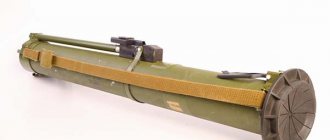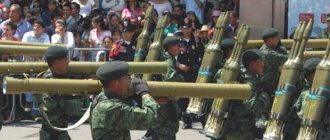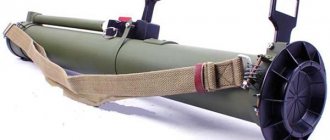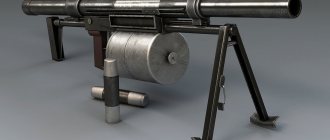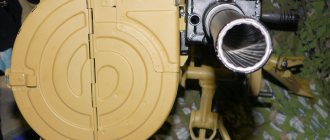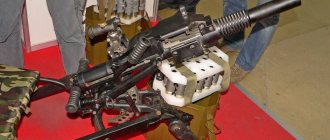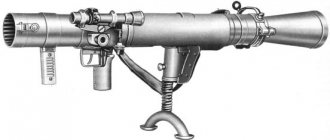The RPG-18 “Mukha” anti-tank rocket launcher was created to destroy enemy shelters, fortifications and armored targets, as well as to eliminate manpower located in urban structures and light shelters. The grenade launcher is a disposable weapon.
The RPG-18 is the Soviet equivalent of the M72 Lowe grenade launcher produced in America in the 1960s. At the moment, the armor penetration of the RPG-18 is no longer sufficient to destroy the latest generation of armored tanks, but it can be used quite effectively to destroy light vehicles, armored infantry vehicles and fortified fire targets.
History of the use of RPG-18
The “fly” grenade launcher is one of the most common disposable grenade launchers in the world. They were actively used in combat operations in Afghanistan, Chechnya and Iraq.
The RPG-18 was successfully used by illegal armed groups and the Russian Army during both Chechen campaigns. When militants used these weapons against tanks, quite good results were obtained. Even “active armor” in many cases did not save against this weapon. But using this weapon (for example, the T-90) against modern tanks is ineffective due to insufficient armor penetration.
The “fly” grenade launcher was produced not only in the Soviet Union; after the Warsaw Pact collapsed in the 1980s, production of the RPG-18 began in several countries that were its participants.
According to data published in the open press, the “fly” hand-held anti-tank grenade launcher was produced by industry until 1993. In total, approximately 1.5 million RPG-18s were produced. On the international military market, the cost of a grenade launcher at prices of those years was estimated at 721 US dollars. According to forecasts, due to the ease of manufacture of this weapon, it will be popular for a long time.
Instead of the RPG-18, the Soviet Army was supplied with the RPG-22, a more advanced rocket-propelled grenade, for production and armament.
What is a grenade launcher?
Today it is difficult to imagine the armed forces without grenade launchers. The grenade launcher was first proposed at the end of the 18th century and was a relatively small hand-held mortar with which it was possible to throw large projectiles over long distances. They were first introduced on Russian territory during the reign of Peter the Great.
Since the use of the first, rather primitive designs, the weapons industry has not stood still, and modern grenade launchers bear little resemblance to their predecessors.
A grenade launcher is a weapon for hitting large targets at long or medium distances with large-sized ammunition, which is many times larger in size and destructive power than conventional small arms cartridges.
Mainly, grenade launchers are used to destroy large enemy equipment or structures, but they can also be directed against enemy personnel.
History of the creation of the RPG-18
The first single-use anti-tank rocket launcher in the USSR was created by a design group, the main leading designers of which were I.E. Rogozin. and Baraboshkin V.I.
In the course of detailed and lengthy development, the RPG-18 was invented. In the course of testing its characteristics and performance, the name “Mukha” became attached to the grenade launcher, which was associated with the unique design of the front sight.
In 1971, the hand grenade launcher successfully passed field tests, and already in 1972 it was put into service with the Soviet Army. Thus, the RPG-18 hand-held anti-tank grenade launcher replaced the RKG-3, an anti-tank cumulative grenade.
The idea of creating a “disposable” grenade launcher was not new. However, a distinctive feature of the new product from the Swiss Miniman grenade launcher, which was in service with many armies at that time, was that the grenade had a jet engine.
However, the RPG-18 was created according to a scheme proven at that time, which consisted of a launch container (it was also used for storage and transportation) and a striking element. The container was equipped with:
- trigger mechanism,
- sight.
It represented a double telescopic tube - there was an aluminum tube inside the fiberglass tube.
Description of the RPG-18 device
The grenade launcher's launcher is similar to the M72 system; its barrel consists of two pipes connected telescopically. Inside the fiberglass pipe there is a pipe made of aluminum alloy.
The upper tube is made of T13 grade fiberglass, which is impregnated with EP-5122 varnish. For the inner pipe, aluminum alloy 65KhZAMg6M or 65KhZD1T was used. the pipes in the stowed position are located one inside the other, they are 705 mm long. To fire a shot, the pipes move apart to form a barrel with a total length of 1050 mm.
The grenade is secured with stoppers in the inner tube; it consists of steel plates with a cutout, which are placed on two stabilizer feathers. At the other end of the plate, their bend is linked to the cut end of the barrel.
The firing process is as follows:
- To transfer the “Fly” to the combat position from the traveling position, open the back cover, then push the pipes all the way. The front cover will open, and the front sight and safety post with diopter will take a vertical position.
- The front sight has a frame made of glass with printed numbers and marks 5, 10, 15, 20, they represent the firing range of 50, 100, 150 and 200 meters. There are horizontal strokes on both sides at the level of the top point of the “15” aiming mark; they can be used to determine the distance to the tank. The distance is determined as follows: if the horizontal lines are the width of the frontal projection of the tank hull, then 150 m remains to the target.
- if the horizontal strokes are smaller than the width of the frontal projection of the tank hull, then less than 150 m will remain to the target.
- if the horizontal strokes are greater than the width of the frontal projection of the tank hull, then more than 150 m will remain to the target.
The locking mechanism, which is located on the inner tube at the rear of the body, serves as a locking mechanism for the striking mechanism in the stowed position, this prevents the igniter primer from breaking when the tubes are folded. In addition, the locking mechanism prevents a shot if the pipes are not completely retracted; in the firing position, it blocks the fixation of the pipes. The locking mechanism thus ensures safety when moving the pipes apart.
Shooting process
The Aglen grenade launcher has no recoil when fired. Shooting is done from the shoulder.
Ukrainian soldier with RPG-26
First, you need to turn the front sight all the way up, then remove the pin and unlock the trigger, and then raise the safety post all the way up. After pressing the trigger, the grenade is ejected from the launch tube due to the energy of the combustible powder charge. Next, the fins (stabilizers) are deployed to balance the grenade in flight.
Shooting from RPG-26
Then the grenade flies to the target. When colliding with an obstacle, the fuse is triggered and a cumulative jet is created, which should burn through the armor. In the event of a “non-collision” with the target, the fuse remotely self-destructs.
Performance characteristics
- Caliber – 64 mm.
- Weight – 2.6 kg.
- Length – 705 (1050) mm.
- The direct shot range is 135 m.
- The sighting range is 200 m.
- Armor penetration at 90 degrees is 300 mm, at 60 degrees - 150 mm.
- The mass of the grenade is 1.4 kg.
- The initial speed of the grenade is 114 m/s.
- The caliber of the grenade head is 64 mm.
It will take 8-10 seconds to bring the RPG-18 grenade launcher into combat mode. The grenade can penetrate up to 300 mm of armored steel. The grenade has a caliber of 64 mm. When leaving the barrel, the initial speed of the grenade is 114 m/s.
PG-18 grenade
The grenade has a caliber warhead and a jet engine. The jet engine contains a reactive charge consisting of PPK-5 gunpowder. The explosive okfol is used as an explosive projectile, which is a chemical compound that causes detonation under certain conditions.
Okfol is located in the main part of the grenade and weighs 312 grams.
A jet engine is threaded to the rear of the grenade body. In the engine chamber there is a charge with pyroxylin powder in the form of tubes. The chamber ends with a nozzle block with a stabilizer of four blades and a boost unit. In the transition bottom there are inclined holes through which flowing powder gases pass. They impart rotation to the grenade at approximately 10 revolutions per second. At the time of departure, the grenade reaches a speed of 114 m/s.
The grenade flies like a ballistic body, which is why it is practically insensitive to side winds.
Video about RPG-18
Shot from a Mukha grenade launcher
Classification and features
It has a high rate of fire when fired and can hit targets at a distance of up to 2.5 km.
Grenade launcher is a collective name for any weapon with high lethal force and large-sized ammunition. The following types of such weapons are distinguished:
- muzzle;
- under-barrel;
- easel;
- manual;
- reactive.
All these types of weapons differ in characteristics and purpose, are used for different purposes and have many differences.
Features of muzzle grenade launchers
Muzzle grenade launchers were created specifically to be able to throw rifle grenades. This type of grenade is launched under the pressure of powder gases, which allows it to be thrown over a long distance.
Throwing a projectile with a muzzle grenade launcher is carried out using a blank or live cartridge (a blank cartridge is mainly used). Systems that involve firing a live cartridge are practically not widespread, since in this case the grenade must be equipped with a through hole for the cartridge to exit, or with a bullet catcher, which complicates the process of producing ammunition.
There are two types of such guns – barreled and barrelless.
The barrel system is a mortar attached to the muzzle of a machine gun. The grenade is accelerated by a blank shot. This type was common in the first half of the 20th century.
Interesting! It was barrel grenade launchers that were widely used during World War II.
A barrelless muzzle grenade launcher is a special rod that is installed in the barrel, and then, under the action of powder gases, pushes the grenade out. Such systems are still used by the armed forces of some countries, including the United States, Serbia and Great Britain.
